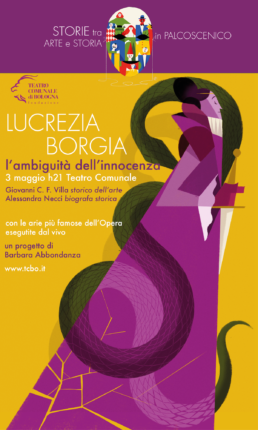STORIE tra arte e storia in palcoscenico
Lucrezia Borgia: l’ambiguità dell'innocenza
“I capelli più biondi che si possano immaginare”, esclama Lord Byron dopo averne trafugato uno dal ricciolo di Lucrezia Borgia, riemerso da una lettera dell’epistolario da lei intrattenuto per sedici anni con Pietro Bembo, allora giovane e dotto umanista. Figlia del futuro papa Alessandro VI, maritata con alcune tra le casate più potenti dell’epoca – gli Sforza, gli Aragona e infine gli Este – la vita di Lucrezia Borgia è stata narrata da scrittori, filosofi, storici nella logica ottocentesca di un feuilleton fondato su infamie create ad arte nel Cinquecento per fornire l’immagine di una donna sanguinaria, dissoluta, incestuosa, avvelenatrice, succube nell’accettare ogni corruzione. Un mito popolare alimentato dalla tragedia in prosa di Victor Hugo (1833) e animato dalle note musicali di Gaetano Donizetti (1855), che hanno fatto il destino letterario e postumo di Lucrezia Borgia essere ben più crudele e ingiusto di tutte le sopraffazioni subite in vita. Se fin dall’infanzia Lucrezia è gestita dal padre Rodrigo e dal fratello Cesare in modo strumentale agli interessi finanziari e politici della famiglia e del papato, Lucrezia avrà poi la formidabile capacità di affrancarsi, avendo prima il coraggio di opporsi per poi, sposa di Alfonso I d’Este e quindi duchessa di Ferrara per quindici anni, contribuire a un periodo di grande splendore del ducato, favorito dalle sue formidabili capacità diplomatiche e di attivo mecenatismo. I trentanove anni di vita di Lucrezia Borgia consacrandosi quali la perfetta espressione del farsi del Rinascimento italiano.
con
Alessandra Necci biografa storica
Alessandra Necci è una biografa storica, autrice di numerose biografie di successo, che hanno vinto molti premi. Si è dedicata, in particolare, allo studio di Napoleone Bonaparte della sua epopea, nonché alla fase della Rivoluzione francese, del Consolato e dell’Impero. Ancora, ha studiato e scritto di Rinascimento italiano e francese del Seicento francese. Avvocato, si è specializzata a Sciences Po a Parigi ed è professore alla LUISS Guido Carli di Roma.
Giovanni Carlo Federico Villa storico dell’arte
Giovanni Carlo Federico Villa, docente universitario di Storia dell’Arte Moderna, Direttore di Palazzo Madama Museo Civico d’Arte Antica di Torino, è autore di importanti monografie e numerose sono le sue presenze divulgative sui principali canali radiotelevisivi italiani e stranieri.
Estratti musicali dalle arie più famose dell’Opera eseguite dal vivo
Un progetto di Barbara Abbondanza
3 MAGGIO | H 21.00
Teatro Comunale
prezzo
Biglietto intero- 10€ Sconto abbonati
- 5€ Sconto U30




